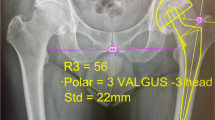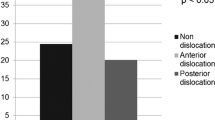Abstract
Purpose
Direct anterior approach (DAA) has recently become popular in total hip arthroplasty (THA). However, irrespective of the surgical approach used, component malposition is an important factor affecting function and complications after THA. This study aims to compare component positioning on the femoral and acetabular side between DAA and posterior approach (PA) to the hip joint. We hypothesized that the two approaches are similar in terms of component positioning.
Methods
We prospectively studied 50 patients, matched according to age, sex, and body mass index, undergoing THA, divided non-randomly into 2 groups. Group 1 comprised 25 patients (35 hips) undergoing THA using DAA and group 2 comprised 25 patients (25 hips) undergoing THA using PA. Ten patients from group 1 had simultaneous bilateral THA. Radiological parameters studied were acetabular inclination (AI), coronal femoral stem alignment (CFA), leg length difference (LLD), acetabular cup version (AV), and femoral stem version (FV).
Results
There was no significant difference in AI, CFA, LLD, AV, and FV between the two groups. Excellent to good inter and intra-observer reliability expressed in terms of intraclass correlation coefficient (ICC) was noted for all the radiographic measurements.
Conclusion
Both DAA and PA for THA achieve comparable radiological component positioning. DAA may not provide any advantage over PA in terms of positioning of the prosthesis.
Level of Evidence
Level II, non-randomized comparative study.





Similar content being viewed by others
References
Petis, S., Howard, J. L., Lanting, B. L., & Vasarhelyi, E. M. (2015). Surgical approach in primary total hip arthroplasty: anatomy, technique and clinical outcomes. Canadian Journal of Surgery, 58, 128–139. https://doi.org/10.1503/cjs.007214.
Mohan, K. (2017). The direct anterior approach to the hip joint. Ortho & Rheum Open Access, 9(3), 555761. https://doi.org/10.19080/OROAJ.2017.09.555761.
Paillard, P. (2007). Hip replacement by a minimal anterior approach. International Orthopaedics, 31(Suppl 1), S13-15. https://doi.org/10.1007/s00264-007-0433-7.
Wang, Z., Hou, J.-Z., Wu, C.-H., Zhou, Y.-J., Gu, X.-M., Wang, H.-H., et al. (2018). A systematic review and meta-analysis of direct anterior approach versus posterior approach in total hip arthroplasty. Journal of Orthopaedic Surgery and Research, 13, 229. https://doi.org/10.1186/s13018-018-0929-4.
Christensen, C. P., & Jacobs, C. A. (2015). Comparison of patient function during the first six weeks after direct anterior or posterior total hip arthroplasty (THA): a randomized study. Journal of Arthroplasty, 30, 94–97. https://doi.org/10.1016/j.arth.2014.12.038.
Zawadsky, M. W., Paulus, M. C., Murray, P. J., & Johansen, M. A. (2014). Early outcome comparison between the direct anterior approach and the mini-incision posterior approach for primary total hip arthroplasty: 150 consecutive cases. Journal of Arthroplasty, 29, 1256–1260. https://doi.org/10.1016/j.arth.2013.11.013.
Zhao, H.-Y., Kang, P.-D., Xia, Y.-Y., Shi, X.-J., Nie, Y., & Pei, F.-X. (2017). Comparison of early functional recovery after total hip arthroplasty using a direct anterior or posterolateral approach: a randomized controlled trial. Journal of Arthroplasty, 32, 3421–3428. https://doi.org/10.1016/j.arth.2017.05.056.
Restrepo, C., Parvizi, J., Pour, A. E., & Hozack, W. J. (2010). Prospective randomized study of two surgical approaches for total hip arthroplasty. Journal of Arthroplasty, 25(671–679), e1. https://doi.org/10.1016/j.arth.2010.02.002.
Post, Z. D., Orozco, F., Diaz-Ledezma, C., Hozack, W. J., & Ong, A. (2014). Direct anterior approach for total hip arthroplasty: indications, technique, and results. Journal of American Academy of Orthopaedic Surgeons, 22, 595–603. https://doi.org/10.5435/JAAOS-22-09-595.
Tsukada, S., & Wakui, M. (2015). Lower dislocation rate following total hip arthroplasty via direct anterior approach than via posterior approach: five-year-average follow-up results. The Open Orthopaedics Journal, 9, 157–162. https://doi.org/10.2174/1874325001509010157.
Sheth, D., Cafri, G., Inacio, M. C. S., Paxton, E. W., & Namba, R. S. (2015). Anterior and anterolateral approaches for tha are associated with lower dislocation risk without higher revision risk. Clinical Orthopaedics, 473, 3401–3408. https://doi.org/10.1007/s11999-015-4230-0.
Schloemann, D. T., Edelstein, A. I., & Barrack, R. L. (2019). Changes in acetabular orientation during total hip arthroplasty. The Bone & Joint Journal, 101, 45–50. https://doi.org/10.1302/0301-620X.101B6.BJJ-2018-1335.R1.
Grammatopoulos, G., Gofton, W., Cochran, M., Dobransky, J., Carli, A., Abdelbary, H., et al. (2018). Pelvic positioning in the supine position leads to more consistent orientation of the acetabular component after total hip arthroplasty. The Bone & Joint Journal, 100-B, 1280–1288. https://doi.org/10.1302/0301-620X.100B10.BJJ-2018-0134.R1.
Rathod, P. A., Bhalla, S., Deshmukh, A. J., & Rodriguez, J. A. (2014). Does fluoroscopy with anterior hip arthroplasty decrease acetabular cup variability compared with a nonguided posterior approach? Clin Orthop, 472, 1877–1885. https://doi.org/10.1007/s11999-014-3512-2.
Lin, T. J., Bendich, I., Ha, A. S., Keeney, B. J., Moschetti, W. E., & Tomek, I. M. (2017). A comparison of radiographic outcomes after total hip arthroplasty between the posterior approach and direct anterior approach with intraoperative fluoroscopy. Journal of Arthroplasty, 32, 616–623. https://doi.org/10.1016/j.arth.2016.07.046.
Ji, W., & Stewart, N. (2016). Fluoroscopy assessment during anterior minimally invasive hip replacement is more accurate than with the posterior approach. International Orthopaedics, 40, 21–27. https://doi.org/10.1007/s00264-015-2803-x.
Slotkin, E. M., Patel, P. D., & Suarez, J. C. (2015). Accuracy of fluoroscopic guided acetabular component positioning during direct anterior total hip arthroplasty. Journal of Arthroplasty, 30, 102–106. https://doi.org/10.1016/j.arth.2015.03.046.
Hartford, J. M., & Bellino, M. J. (2017). The learning curve for the direct anterior approach for total hip arthroplasty: A single surgeon’s first 500 cases. Hip Int, 27, 483–488. https://doi.org/10.5301/hipint.5000488.
Moretti, V. M., & Post, Z. D. (2017). Surgical approaches for total hip arthroplasty. Indian Journal Orthopaedics, 51, 368–376. https://doi.org/10.4103/ortho.IJOrtho_317_16.
Werner, B. C., & Brown, T. E. (2012). Instability after total hip arthroplasty. World Journal of Orthopaedics, 3, 122–130. https://doi.org/10.5312/wjo.v3.i8.122.
Krenzel, B. A., Berend, M. E., Malinzak, R. A., Faris, P. M., Keating, E. M., Meding, J. B., et al. (2010). High preoperative range of motion is a significant risk factor for dislocation in primary total hip arthroplasty. Journal of Arthroplasty, 25, 31–35. https://doi.org/10.1016/j.arth.2010.04.007.
Masonis, J. L., & Bourne, R. B. (2002). Surgical approach, abductor function, and total hip arthroplasty dislocation. Clincal Orthopaedics, 405, 46–53. https://doi.org/10.1097/00003086-200212000-00006.
Rogers, M., Blom, A. W., Barnett, A., Karantana, A., & Bannister, G. C. (2009). Revision for recurrent dislocation of total hip replacement. Hip Int J Clin Exp Res Hip Pathol Ther, 19, 109–113. https://doi.org/10.1177/112070000901900205.
Mahoney, C. R., & Pellicci, P. M. (2003). Complications in primary total hip arthroplasty: avoidance and management of dislocations. Instructional Course Lectures, 52, 247–255.
Barrett, W. P., Turner, S. E., & Leopold, J. P. (2013). Prospective randomized study of direct anterior vs postero-lateral approach for total hip arthroplasty. Journal of Arthroplasty, 28, 1634–1638. https://doi.org/10.1016/j.arth.2013.01.034.
Cheng, T. E., Wallis, J. A., Taylor, N. F., Holden, C. T., Marks, P., Smith, C. L., et al. (2017). A prospective randomized clinical trial in total hip arthroplasty-comparing early results between the direct anterior approach and the posterior approach. Journal of Arthroplasty, 32(3), 883–890.
Zhang, X. L., Wang, Q., & Jiang, Y. (2006). Zeng BF Minimally invasive total hip arthroplasty with anterior incision. Zhonghua wai ke za zhi, 44(8), 512–515.
Luo, Z. L., Chen, M., Shang, X. F., et al. (2016). Direct anterior approach versus posterolateral approach for total hip arthroplasty in the lateral decubitus position. Zhonghua Yi Xue Za Zhi, 96, 2807–2812.
Mushtaq, N., To, K., Gooding, C., & Khan, W. (2019). Radiological imaging evaluation of the failing total hip replacement. Frontiers in Surgery. https://doi.org/10.3389/fsurg.2019.00035.
Sutherland, C. J., Wilde, A. H., Borden, L. S., & Marks, K. E. (1982). A ten-year follow-up of one hundred consecutive Müller curved-stem total hip-replacement arthroplasties. Journal of Bone and Joint Surgery American Volume, 64, 970–982.
Reina, N., Salib, C. G., Perry, K. I., Hanssen, A. D., Berry, D. J., & Abdel, M. P. (2019). Mild coronal stem malalignment does not negatively impact survivorship or clinical results in uncemented primary total hip arthroplasties with dual-tapered implants. Journal of Arthroplasty, 34, 1127–1131. https://doi.org/10.1016/j.arth.2019.01.055.
Meermans, G., Malik, A., Witt, J., & Haddad, F. (2011). Preoperative radiographic assessment of limb-length discrepancy in total hip arthroplasty. Clinical Orthopaedics, 469, 1677–1682. https://doi.org/10.1007/s11999-010-1588-x.
Kjellberg, M., Al-Amiry, B., Englund, E., Sjödén, G. O., & Sayed-Noor, A. S. (2012). Measurement of leg length discrepancy after total hip arthroplasty. The reliability of a plain radiographic method compared to CT-scanogram. Skeletal Radiology, 41, 187–191. https://doi.org/10.1007/s00256-011-1166-7.
Wines, A. P., & McNicol, D. (2006). Computed tomography measurement of the accuracy of component version in total hip arthroplasty. Journal of Arthroplasty, 21, 696–701. https://doi.org/10.1016/j.arth.2005.11.008.
Fujishiro, T., Hayashi, S., Kanzaki, N., Hashimoto, S., Kurosaka, M., Kanno, T., et al. (2014). Computed tomographic measurement of acetabular and femoral component version in total hip arthroplasty. International Orthopaedics, 38, 941–946. https://doi.org/10.1007/s00264-013-2264-z.
Lewinnek, G. E., Lewis, J. L., Tarr, R., Compere, C. L., & Zimmerman, J. R. (1978). Dislocations after total hip-replacement arthroplasties. Journal of Bone and Joint Surgery. American Volume, 60, 217–220.
Hamilton, W. G., Parks, N. L., & Huynh, C. (2015). Comparison of cup alignment, jump distance, and complications in consecutive series of anterior approach and posterior approach total hip arthroplasty. Journal of Arthroplasty, 30(11), 1959–1962. https://doi.org/10.1016/j.arth.2015.05.022.
Abdel, M. P., von Roth, P., Jennings, M. T., Hanssen, A. D., & Pagnano, M. W. (2016). What safe zone? the vast majority of dislocated THAs are within the lewinnek safe zone for acetabular component position. Clinical Orthopaedics, 474, 386–391. https://doi.org/10.1007/s11999-015-4432-5.
Tezuka, T., Heckmann, N. D., Bodner, R. J., & Dorr, L. D. (2019). Functional safe zone is superior to the lewinnek safe zone for total hip arthroplasty: why the lewinnek safe zone is not always predictive of stability. Journal of Arthroplasty, 34, 3–8. https://doi.org/10.1016/j.arth.2018.10.034.
Alexandrov, T., Ahlmann, E. R., Menendez, L. R. (2014) Early Clinical and Radiographic Results of Minimally Invasive Anterior Approach Hip Arthroplasty. Adv Orthop 2014:e954208. https://www.hindawi.com/journals/aorth/2014/954208/. Accessed 7 Jul 2020
Beamer, B. S., Morgan, J. H., Barr, C., Weaver, M. J., & Vrahas, M. S. (2014). Does fluoroscopy improve acetabular component placement in total hip arthroplasty? Clin Orthop, 472, 3953–3962. https://doi.org/10.1007/s11999-014-3944-8.
Matta, J. M., Shahrdar, C., & Ferguson, T. (2005). Single-incision anterior approach for total hip arthroplasty on an orthopaedic table. Clin Orthop, 441, 115–124. https://doi.org/10.1097/01.blo.0000194309.70518.cb.
Bingham, J. S., Spangehl, M. J., Hines, J. T., Taunton, M. J., & Schwartz, A. J. (2018). Does intraoperative fluoroscopy improve limb-length discrepancy and acetabular component positioning during direct anterior total hip arthroplasty? Journal of Arthroplasty, 33, 2927–2931. https://doi.org/10.1016/j.arth.2018.05.004.
Peng, L., Zeng, Y., Wu, Y., Zeng, J., Liu, Y., & Shen, B. (2020). Clinical, functional and radiographic outcomes of primary total hip arthroplasty between direct anterior approach and posterior approach: a systematic review and meta-analysis. BMC Musculoskelet Disord, 21, 338. https://doi.org/10.1186/s12891-020-03318-x.
Funding
Nil.
Author information
Authors and Affiliations
Corresponding author
Ethics declarations
Conflict of Interest
The author(s) declared no potential conflicts of interest with respect to the research, authorship, and/or publication of this article.
Ethical Approval
The institutional ethics committee approved the study. Each author certifies that he or she has no commercial associations (eg, consultancies, stock ownership, equity interest, patent/licensing arrangements, etc.) that might pose a conflict of interest in connection with the submitted article. The study was conducted in All India Institute of Medical Sciences, Rishikesh, India.
Informed Consent
Informed consent was obtained from all individual participants included in the study.
Additional information
Publisher's Note
Springer Nature remains neutral with regard to jurisdictional claims in published maps and institutional affiliations.
Rights and permissions
About this article
Cite this article
Goyal, T., Choudhury, A.K., Paul, S. et al. Acetabular and Femoral Component Positioning Using Direct Anterior Approach Versus Posterior Approach in Total Hip Arthroplasty. JOIO 55, 1215–1224 (2021). https://doi.org/10.1007/s43465-020-00343-9
Received:
Accepted:
Published:
Issue Date:
DOI: https://doi.org/10.1007/s43465-020-00343-9




